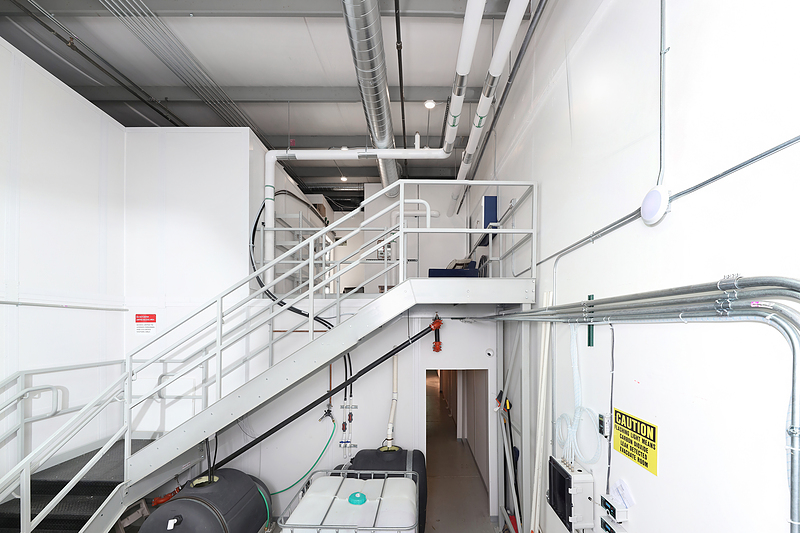What is the AHU Index? Components of AHU Location and configuration of clean room air filters Is the air handling system working 24/7?
1. What is AHU?
AHU – What is an air handling unit?
An air handling unit ( AHU ) is a device that controls the temperature, humidity, and pressurization of controlled environments. As part of the HVAC system, it acts as a high-capacity air handling unit, facilitating the movement and air-conditioning of clean rooms. 304 stainless steel construction with a filter system, back-blowing fan and cooling unit helps to air-condition fresh air into the clean room.
Each clean room requires a powerful air-handling system to manufacture pharmaceuticals, medical equipment, semiconductors, and healthcare products. The floor area in the cleanroom is not redundant and the dedicated clean room HVAC system must share the area with other non-critical air systems.
2. Composition of the AHU
The AHU is comprised of the primary filter, fan, cooling coil and mixing chamber. The inside of the AHU requires streamlined surface features just like in a clean room: a smooth interior texture with no studs, nuts, bolts, screws, or crevices. Damper and damper ensure fan noise and vibration are kept to a minimum.

3. Location and configuration of air filters in clean rooms
A primary filter is installed in front of the HEPA filter in the cleanroom HVAC system to maintain the longevity of the system. The pre-filter helps extend the life of the HEPA filter by removing particles larger than 1 micron. AHU rotors blow air with actuators. The fan controller is either integrated into the automatic control system (Crow Filter Control System) or sometimes via manual control panels. The software system and automatic timer allow lower air flow during times when clean rooms are not used or when operating to a minimum. Power sensor allows to reduce power consumption in the absence of people.
4. Is the air handling system available 24/7?
In general, prolonged shutdown of clean room air systems reduces the life of the filter due to “filter load”. If the air conditioning system is completely disconnected, particles will stick and remain in the filter. When the system is back on, air pressure will affect the particles in the filter. The result is microscopic cracks that lead to leakage, reduced efficiency and reduced filter life.
5. Alternatives to traditional air handling equipment – Advantages of FFU air purifiers for purifying clean room air
Application of FFU
Filter Fan ( Fan Filter Unit – FFU ), is a solution to clean room air filter with a number of advantages compared with the air handling system tradition. They are applicable in both small and large spaces with a low cleanliness rating such as ISO Class 3. The rate of change of the air and the cleanliness requirement determine the number of FFUs needed. An ISO Class 8 cleanroom ceiling can require only 5-15% ceiling coverage while an ISO Class 3 clean room or higher may require 60-100% coverage.
Each FFU filter and housing is customizable in terms of filter size, airflow rate and options. This allows for further adjustment of the clean room space based on budget and process sensitivity. Clean areas have the most stringent procedures that can deploy FFUs with ULPA filters . A higher rate of air exchange improves particle filtration but also increases procurement and maintenance costs. More functional and filter-simpler FFUs (eg using HEPA filters) can be deployed where there are less critical activities.
6. Install FFU
These systems are very flexible and can easily replace filters when needed. Expanding clean rooms or increasing air change rates do not require the HVAC contractor to run additional ducts or make significant changes to the existing HVAC system. Installation can generally be handled by small teams without the need for a forklift.
7. Fan filter
Each FFU can be replaced as needed. Unlike a dedicated air conditioning unit such as an AHU, filter maintenance in an FFU does not require a complete system shutdown. Maintenance-replacement FFU can be switched off independently, while other equipment can still function normally to maintain the cleanliness of the space (taking into account, of course, the level of decreased slightly due to lack of 1 device). FFUs are not only easy to maintain and maintain when needed, but also produce much lower noise during operation.
These self-contained filters are equipped with HEPA that is 99.99% efficient or ULPA 99.995% efficient for many critical applications.
source: https://vietnamcleanroom.com/ffu-vs-ahu-cho-phong-sach

